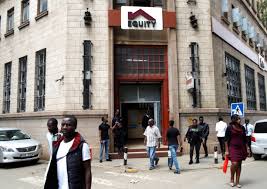Equity Group Market Value Crosses Landmark Threshold
Equity Group (NSE: EQTY) surpasses KSh 250 bn value as profit jumps 20%, outpacing peers KCB (NSE: KCB) and COOP (NSE: COOP); yields (KE10Y) stay high as investors shift to equities for real returns.

Equity Group Holdings (NSE: EQTY) has achieved a historic valuation milestone, surpassing KSh 250 billion ($1.9 billion) in market capitalization to become Kenya’s most valuable listed bank. This achievement is not merely an equity market record; it represents a structural validation of Kenya’s banking sector reforms, regional diversification, and digital transformation that have collectively redefined frontier-market scalability. With total assets of KSh 1.7 trillion and 20% year-on-year profit growth, Equity’s ascent encapsulates the post-COVID consolidation phase where capital efficiency, regional balance sheet integration, and cost rationalization have created systemic differentiation.
Kenya’s financial sector has rebounded strongly since 2022, with credit to the private sector rising 13.8% year-on-year and nonperforming loans declining to 13.3%, their lowest level in five years. Equity’s performance is central to this narrative. Its net interest margin of 8.9% and cost-to-income ratio of 47% position it ahead of regional peers such as KCB Group (NSE: KCB) and Co-operative Bank (NSE: COOP). The valuation reflects investor confidence in the bank’s pan-regional strategy spanning Uganda, Rwanda, Tanzania, DRC, and South Sudan, markets contributing 37% of total profit before tax in 2025.
The milestone also demonstrates Kenya’s capital market resilience amid high sovereign yields. With the 10-year eurobond yield (NSE: KE10Y) averaging 10.9% and inflation at 6.1%, investors have shifted selectively from sovereign to equity instruments offering real return prospects. Equity’s dividend yield of 4.3% and return on equity of 24% place it among Africa’s top five frontier banking plays. Institutional investors, particularly regional pension funds, have increased holdings by 15% year-to-date, signaling deeper domestic financialization despite currency volatility that saw the shilling hover near KES/USD 157.
At a macro level, the bank’s expansion mirrors structural trends in East African credit intermediation. Equity’s regional subsidiaries collectively manage 3.8 million MSME accounts, injecting nearly KSh 280 billion in cross-border working-capital finance. This network effect enhances financial inclusion and foreign-exchange liquidity within a region where banking penetration averages just 38%. The capital-market signal is therefore double-layered: Kenya retains financial-center dominance while Equity’s franchise embodies the decentralization of banking capital across emerging economies.
The rise in market value also contributes to NSE capitalization depth, lifting the total banking sector’s share to 46% of the bourse, up from 41% in 2023. This re-rating improves index weighting within MSCI Frontier Markets (Ticker: MSCIFM), enhancing passive inflow potential. On valuation metrics, the stock trades at a forward price-to-book of 1.2x, still below the African peer median of 1.5x, implying room for further upside if earnings growth remains above 18%.
Yet risks remain. Elevated cost of funds under Kenya’s tight monetary stance could pressure margins, while regional currency depreciation may dilute translated earnings. Furthermore, sovereign risk remains a drag, with domestic debt service consuming 62% of Kenya’s revenue base. Still, the structural foundation appears intact. Equity’s $300 million Tier-II green bond issuance scheduled for early 2026 is expected to enhance its capital adequacy ratio to 18%, bolstering credit expansion capacity across ESG-linked portfolios.
By late 2026, the sustainability of Equity’s valuation will depend on two quantitative thresholds: maintaining ROE above 20% and cost of risk below 3%. Achieving both would consolidate its position as Sub-Saharan Africa’s premier frontier bank by market efficiency, underpinning a broader re-rating of Kenya’s equity market and solidifying investor confidence in the region’s financial sector reforms.




